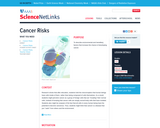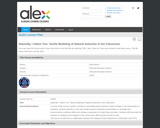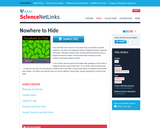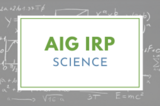
This parent guide supports parents in helping their child at home with the 7th grade Science content.
- Subject:
- Science
- Material Type:
- Reference Material
- Vocabulary
- Author:
- Kelly Rawlston
- Letoria Lewis
- Date Added:
- 10/11/2022

This parent guide supports parents in helping their child at home with the 7th grade Science content.

This resource accompanies our Rethink 7th Grade Science course. It includes ideas for use, ways to support exceptional children, ways to extend learning, digital resources and tools, tips for supporting English Language Learners and students with visual and hearing impairments. There are also ideas for offline learning.

Students describe environmental and herditary factors that increase the chance of developing cancer.

In this lesson, students examine a case study of a woman with a family history of diabetes and create a family health portrait that will assess her risk of developing type 2 diabetes. Using the family health portrait to record the woman's family history, students identify her genetic, behavioral, and environmental risk factors for type 2 diabetes and make recommendations for lifestyle changes.

In this video module, students learn how scientists use genetic information from dogs to find out which gene (out of all 20,000 dog genes) is associated with any specific trait or disease of interest. This method involves comparing hundreds of dogs with the trait to hundreds of dogs not displaying the trait, and examining which position on the dog DNA is correlated with the trait (i.e. has one DNA sequence in dogs with the trait but another DNA sequence in dogs not displaying the trait). Students will also learn something about the history of dog breeds and how this history helps us find genes.

Students will learn how climate change poses risks to human health. Students will realize we need to safeguard our communities by protecting people’s health and quality of life from climate change impacts. Students will apply what they have learned and discuss in groups how the U.S. could apply their research and support toward third world countries. The standards tagged are for the entire series of lessons as a whole. This lesson was developed by Marty Ervin as part of their completion of the North Carolina Global Educator Digital Badge program. This lesson plan has been vetted at the local and state level for standards alignment, Global Education focus, and content accuracy.

Students will learn how climate change poses risks to human health. Students will realize we need to safeguard our communities by protecting people’s health and quality of life from climate change impacts. The standards tagged are for the entire series of lessons as a whole. This lesson was developed by Marty Ervin as part of their completion of the North Carolina Global Educator Digital Badge program. This lesson plan has been vetted at the local and state level for standards alignment, Global Education focus, and content accuracy.

Students will understand how climate change can affect human health and how some populations will be especially affected. Students will investigate different countries of the world and how these countries contribute to air pollution and global warming. The standards tagged are for the entire series of lessons as a whole. This lesson was developed by Marty Ervin as part of their completion of the North Carolina Global Educator Digital Badge program. This lesson plan has been vetted at the local and state level for standards alignment, Global Education focus, and content accuracy.

Students will consider multiple perspectives of other cultures and countries. They will realize that global warming may not be a priority in countries where the basic population is struggling to maintain an existence. Students will understand how difficult it is to insure all countries of the world reduce their contribution to global warming and follow the lead of the United States. Students will create a proposed action plan for how they will act and educate others on the impact on human health of global warming. Students will apply their knowledge and discoveries from this unit to propose how they teach others about the importance of reducing their own carbon footprint. The standards tagged are for the entire series of lessons as a whole. This lesson was developed by Marty Ervin as part of their completion of the North Carolina Global Educator Digital Badge program. This lesson plan has been vetted at the local and state level for standards alignment, Global Education focus, and content accuracy.

Students will consider multiple perspectives of other cultures and countries. They will realize that global warming may not be a priority in countries where the basic population is struggling to maintain an existence. Students will understand how difficult it is to insure all countries of the world reduce their contribution to global warming and follow the lead of the United States. Students will create a proposed action plan for how they will act and educate others on the impact on human health of global warming. Students will apply their knowledge and discoveries from this unit to propose how they teach others about the importance of reducing their own carbon footprint. The standards tagged are for the entire series of lessons as a whole. This lesson was developed by Marty Ervin as part of their completion of the North Carolina Global Educator Digital Badge program. This lesson plan has been vetted at the local and state level for standards alignment, Global Education focus, and content accuracy.

This article, with embedded video, examines current research on a protein called KLH, or keyhole limpet hemocyanin. KLH is obtained from a snail, the giant keyhole limpet, and is being tested in more than 20 different types of cancer vaccines and on autoimmune diseases like Alzheimer's because of its ability to trigger a powerful immune response.

Students will take on the role of both research biologists and predators to simulate how envrionmental conditions affect and change a population of model frogs and traits. Students will encounter the impacts of mutations and changes to the environment affecting the survival as well.

This interactive tool is based on the classic story of evolution by natural selection - the story of the peppered moths in England during the Industrial Revolution. The simulation uses green and orange bugs to demonstrate how natural selection influences the changes in species over time.

This resource explains why those with sickle cell anemia will not contract malaria.

This course was created by the Rethink Education Content Development Team. This course is aligned to the NC Standards for 7th Grade Science.

This course was created by the Rethink Education Content Development Team. This course is aligned to the NC Standards for 7th Grade Science.

This course was created by the Rethink Education Content Development Team. This course is aligned to the NC Standards for 7th Grade Science.

Students will work in groups (2-4 students per group) to translate the genetic code they receive in the form of a color coded message through various formats ending in their group finding the correct “puzzle piece.” If each group chooses the correct piece when they add together their pieces it will create the protein, Insulin.

This educational module is designed to provide a hands-on approach to learning how genetics determine the fate of a cell. This is an interactive "student-centered" module that utilizes technology, manipulatives, and hands-on activities to provide exceptional resources for teachers and a dynamic learning experience for students with various learning styles. Specifically, the lesson focuses on understanding how Sickle Cell Anemia is an inherited genetic disorder, illustrates how the structure of the red blood cells affect blood flow, and explains how possible gene combinations can be passed from parents to offspring.

In this task, students will assume the role of support group members who must discuss and individually decide on the issue of whether or not to be tested for a genetic trait or disorder. Students will read nonfiction passages regarding this issue to prepare for the support group meeting that will take the form of a Socratic Seminar. Passages should have been selected by the teacher to include examples of genetic disorders with effects that can be mitigated through early detection and appropriate diet or lifestyle choices. Students will then individually state their decisions and support them through written explanations that reference the discussion and provided passages. This lesson was developed by NCDPI as part of the Academically and/or Intellectually Gifted Instructional Resources Project. This lesson plan has been vetted at the state level for standards alignment, AIG focus, and content accuracy.